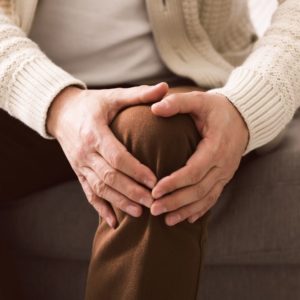Torn Meniscus Doctor in Westchester County, NY

What is a meniscus tear?
A meniscus, which is the piece of cartilage that absorbs shock and protects the end of each of your leg bones, can tear when it is twisted incorrectly, when the joint is hyperextended, or when age causes degenerative damage to it. While this kind of injury can affect anyone, it’s common among athletes and those who are active. On occasion, this kind of injury might occur at the same time as an ACL injury, which is another type of knee injury affecting one of your knee’s ligaments.
Normal Meniscus vs. Torn Meniscus


What causes a meniscus tear?
Most commonly, meniscus injuries happen during sports and other physical activities. Surprisingly though, they can also occur as the result of minor movements, especially in those who are older in age. Below are the most common causes for a meniscus tear:
- Changing directions suddenly
- Twisting the knee suddenly
- Playing sports, especially those involving sudden direction changes
- Lifting weights
What are the symptoms of a meniscus tear?
Symptoms of a meniscus tear that may warrant a visit to Specialty Orthopaedics include the following:
- Knee pain
- Pain in the side of the knee
- Pain in the center of the knee
- Recurring knee pain/pain that comes and goes
- Clicking feeling or sound in the knee
- Knee stiffness
- Immobility/inability to walk
- Inability to straighten the knee
- Knee instability or “knee giving out”
How is a meniscus tear diagnosed?
 Our team has many years of training in treating all kinds of knee injuries, including meniscus tears. You can trust that you’re in excellent hands when it comes to evaluating and diagnosing your knee condition. Our doctors make sure to go over any of your relevant medical history as well as discuss your knee concerns thoroughly before making a diagnosis. We might also conduct an imaging test to further evaluate your condition and get to the bottom of your knee problem. Imaging tests may include:
Our team has many years of training in treating all kinds of knee injuries, including meniscus tears. You can trust that you’re in excellent hands when it comes to evaluating and diagnosing your knee condition. Our doctors make sure to go over any of your relevant medical history as well as discuss your knee concerns thoroughly before making a diagnosis. We might also conduct an imaging test to further evaluate your condition and get to the bottom of your knee problem. Imaging tests may include:
- X-rays
- MRI scans
- CAT scans
How is a meniscus tear treated?
Meniscus injuries are sometimes treated with conservative options, including:
- Rest
- Ice
- Elevation
- Compression
- Strength exercises
- Physical therapy
What happens if a meniscus tear is left untreated?
If you feel you may have torn your meniscus, there isn’t any reason to not have it checked out. As mentioned above, there is a chance a tear on the outer side of the meniscus can heal, but tears on the larger inner portion won’t heal. You can try RICE therapy (that is what we will likely start with as treatment at Specialty Orthopaedics).
But a torn meniscus can often occur along with a tear of your anterior cruciate ligament. This often happens when your injury occurred during a sport or with sudden strong movement. If you’ve torn a ligament along with your meniscus, your knee stability is compromised and you’re now inviting possible larger damage and injury.
Plus, part of your torn meniscus can break off and become lodged in the knee joint itself. Now you’re looking at a broader scope of surgical repair.
If you think you may have torn your meniscus, there’s no reason not to have your knee checked out with the team at Specialty Orthopaedics.
When should I see a doctor for a possible meniscus tear?
 Small meniscus tears may not even be felt. When someone says they have torn cartilage in their knee, this usually means a torn meniscus. The question of whether to see experts such as the team at Specialty Orthopaedics comes down to pain and motion.
Small meniscus tears may not even be felt. When someone says they have torn cartilage in their knee, this usually means a torn meniscus. The question of whether to see experts such as the team at Specialty Orthopaedics comes down to pain and motion.
If you think you may have torn your meniscus, say during a tennis match, as long as you don’t have locking, the first path of treatment should be RICE: rest, ice, compression, and elevation. This may allow your injury to heal. This is especially true with the outer third of the meniscus, which receives a rich supply of blood. Tears in this area can heal on their own or with surgery. Tears in the inner two-thirds of the meniscus, however, cannot heal. This is because this area does not have significant blood supply.
So, when is it time to come see us? If your knee is painful and swelling does not decrease; if your knee locks in certain positions; or if you cannot make any of your usual movements with your knee — these would all dictate making an appointment with the team at Specialty Orthopaedics to have our team of board-certified orthopaedic surgeons check out your knee.
Can a meniscus tear heal on its own?
As is discussed above, meniscus tears on the outer third may be able to heal, especially if they are longitudinal tears. This is because the outer portion of the meniscus still receives excellent blood supply. If the tear is on the inner two thirds, it will not heal. This area doesn’t have adequate blood supply.
When is arthroscopic knee surgery necessary for a torn meniscus?
If conservative RICE practices and subsequent physical therapy to strengthen the surrounding muscles that support your knee have not alleviated your knee pain, or if your knee locks, it is likely time to pursue arthroscopic knee surgery.
If the tear can’t be repaired, the torn area can be trimmed away so that it no longer catches on surrounding bone and tissue when you move your knee.
These are minimally invasive procedures, and they can dramatically improve your knee function and reduce pain.
What are the risks associated with arthroscopic knee surgery?
 Because our Specialty Orthopaedics surgeons enter through very small incisions, arthroscopic surgery is much safer and has less potential for complications than open procedures. Plus, recovery pain and healing time is much less.
Because our Specialty Orthopaedics surgeons enter through very small incisions, arthroscopic surgery is much safer and has less potential for complications than open procedures. Plus, recovery pain and healing time is much less.
The overall risk of complications associated with knee arthroscopy is estimated to be around 5 percent. Serious complications have less than a 1 percent likelihood.
These are the most common risks with these procedures:
- Swelling — Swelling may persist even after surgery.
- Stiffness — Stiffness in the knee can be the result of scar tissue formation.
- Progression of cartilage damage — If a patient has arthritis, there can be a more rapid progression of the condition and of cartilage damage. Remove after arthroscopy.
- Infection —This is very unusual with knee arthroscopy, but it can occur, less than .4% of the time.
- Blood clots —Blood clots can form in the deep veins of the legs. This is increased in patients with blood disorders or genetic conditions. For most patients the risk is very low, and typically only a problem if the patient is not following our instructions on movement and physical therapy after their procedure.
How long does it take to recover and heal after knee arthroscopy for a torn meniscus?
There is variability here depending upon how we addressed your meniscus damage. If we simply shaved away some torn pieces of cartilage, that will be an easier recovery than if we sutured a tear back together.
Most patients can expect their recovery and healing to take about one month. But this can extend with larger repairs to up to three months.
What Surgical Options are There for a Torn Meniscus?
When needed, our doctors are able to provide innovative approaches to meniscus repair surgery, including knee arthroscopy. One of our experienced orthopedic surgeons will discuss all of your options with you during a consultation.
VIDEO: Knee Arthroscopy for Meniscal Repair
Please explore our meniscus repair video below.
Schedule a Consultation
If you are experiencing symptoms of a meniscus tear, visit Specialty Orthopaedics. Our New York orthopedic practice is home to a team of fellowship-trained orthopedists in a variety of orthopedic specialty areas. We offer comprehensive treatment for musculoskeletal disorders in a caring and responsive clinical atmosphere. Give us a call at 914.686.0111 or fill out the form on this page to schedule your appointment today.








